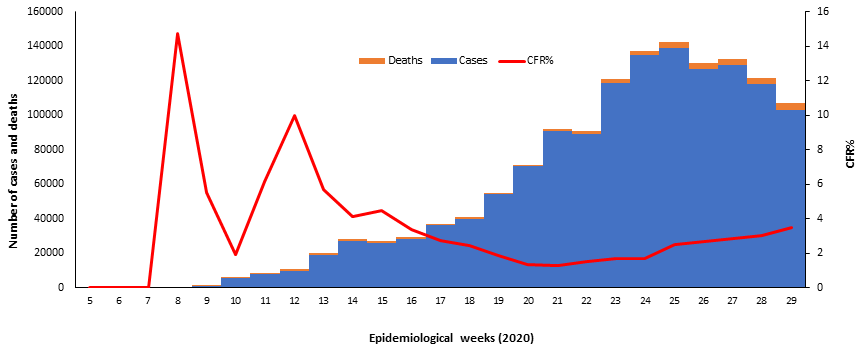Coronavirus disease 2019 (COVID-19) has been spreading for the past 6 months, and it continues to accelerate at regional and global levels. As of 18 July 2020, 13 876 441 cases and 593 087 associated deaths with a case-fatality rate (CFR) of 4.3% have been reported globally. The 22 countries of the Eastern Mediterranean Region (EMR) have reported 1 371 060, which represent about 9.8% of the global count, with 34 087 associated deaths (CFR 2.5%). Most countries in the Region are in the community transmission phase.
Since the beginning of the outbreak, the country that has reported the highest number of total cases in the Region is Islamic Republic of Iran (271 606 cases; 19.8% of the Region’s total), followed by Pakistan (263 496; 19.2%) and Saudi Arabia (248 416; 18.1%). Islamic Republic of Iran also reported the highest number of total associated deaths (13 979; CFR 5.1%) followed by Pakistan (5568; CFR 2.1%) and Egypt (4251; CFR 4.9%). The highest CFR was reported from Yemen (28%) followed by Sudan (6.3%), while the lowest CFR was reported from Qatar (0.1%), followed by Bahrain (0.3%).
During epidemiological week 29, the Region reported less cases, which represents an 12.6% decrease when compared to the 118 109 cases reported during the previous week. The number of associated deaths remains virtually the same (3579 deaths during week 28 compared to 3574 deaths during week 29). Bahrain, Oman and Qatar reported the highest weekly incidence per capita (180, 185.8 and 94 per 100 000 respectively). About two thirds of new cases recorded this week were reported from Islamic Republic of Iran, Saudi Arabia and Pakistan (19.8%, 19.2% and 18.1% respectively). The largest percentage increase in associated deaths was shown in Lebanon, Yemen, Bahrain, occupied Palestinian territory (oPt), Morocco, Syrian Arab Republic and Oman.
For the last 3 weeks (W26-28), the estimated reproductive rate (Rt) showed a significant decrease for Afghanistan, Egypt, Jordan, Morocco, Pakistan, Qatar, Sudan, Somalia and Yemen.
In terms of testing, a total of 16 147 665 laboratory PCR tests were conducted since the start of the outbreak across the Region including 1 575 609 tests in week 29, which represents a 2.8% increase when compared to the number of tests performed in the previous week. The highest number of PCR tests were reported from United Arab Emirates (4.4 million), followed by Saudi Arabia (2.6 million) and Islamic Republic of Iran (2.1 million). The United Arab Emirates and Bahrain are performing the highest rate of testing in terms of testing per capita (45 106/100 000 and 41 766/100 000 respectively). The average positivity rate for the Region is 10.9%. WHO recommends a positivity rate of around 3–12% as a general benchmark indicating adequate testing, which was achieved in most countries of the Region.
The regional incident management support team continues to coordinate the response and provide technical support to countries and partners in the Region in the areas of coordination and partnership, surveillance, laboratory capacity, clinical management, infection prevention and control, risk communication, points of entry according to the International Health Regulations (IHR 2005), research, health system, essential health services and others. Capacity building activities continued with the delivery of the 6th webinar for the COVID-19 Laboratory Community of Practice that focused on antigen-based rapid tests for COVID-19, which was attended by more than 180 participants from EMR and the African Region. Training on ICU clinical management also took place for participants in Afghanistan, oPt, Pakistan and Jordan, while an IPC virtual training on case control and surveillance protocols for infected health care workers was held for Syria and Egypt. The 3rd Edition of the Patient Safety Friendly Hospital Framework was also held as an online workshop.
WHO has also developed and disseminated technical documents to help guide countries’ strategies and policies to manage this pandemic, including updated guidance on transmission of SARS-CoV-2 and the guidance on safe and adequate blood supply were disseminated.

For more data from the Region, please visit the COVID-19 dashboard.
Subscribe to the monthly infectious hazard preparedness newsletter of WHO’s Health Emergencies Programme for latest data and analysis on epidemic- and pandemic-prone diseases, as well as news on outbreak preparedness and response within WHO’s Eastern Mediterranean Region.




